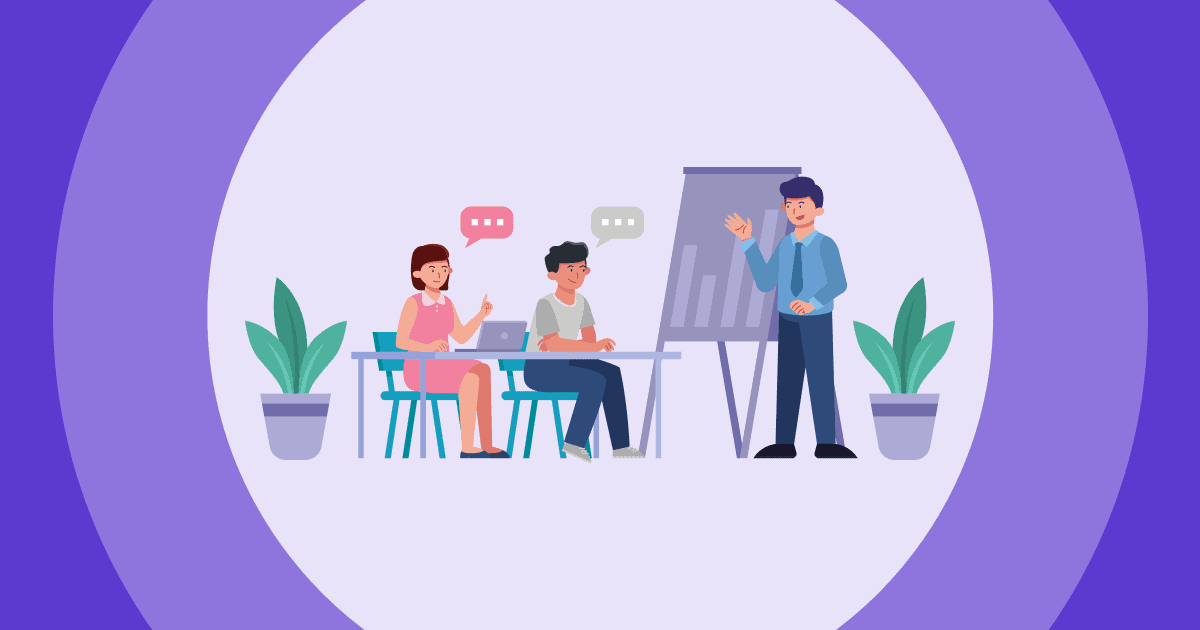Coaching is now a powerful tool for employee development and organizational growth. It has changed how businesses succeed in today's fast-paced world.
In this blog post, we'll explore what coaching is, highlight its significance, and provide coaching in the workplace examples. Additionally, we offer effective strategies that show the true impact of coaching as an essential leadership skill. Let's uncover the potential of coaching together!
Table of Contents

What Is Coaching In The Workplace?
Coaching in the workplace is a process where a trained professional, known as a coach, provides guidance and support to employees to enhance their skills, and performance, and achieve personal and professional goals.
It's like having a personal mentor who helps you become the best version of yourself professionally. Imagine having a coach who listens to your career aspirations, identifies your strengths and areas for improvement, and then guides you on a journey of growth and development.
Why Coaching Is Important More Than Ever
According to Coachhub's findings, a staggering 85% of managers who underwent coaching demonstrated superior soft skills, such as agility and resilience, outshining their non-coached peers. Additionally, a remarkable 70% of coachees attested that coaching significantly enhanced their work-life balance. These results underscore the transformative impact coaching can have on both professional and personal aspects of an individual's life.
In addition, coaching is increasingly essential for the following reasons:
- Navigating Uncertainty: Coaching provides support to handle evolving challenges and make informed decisions.
- Developing Leadership Skills: Leaders enhance communication and decision-making abilities through coaching.
- Fostering Resilience: Coaches encourage a growth mindset and provide tools to handle adversity.
- Enhancing Performance: Coaching identifies strengths and areas for improvement to unlock the full potential.
- Supporting Remote Work: Coaching offers virtual support, keeping remote teams connected and motivated.
- Promoting Well-being: Coaching emphasizes work-life balance and self-care for a healthier workforce.
- Embracing Diversity and Inclusion: Coaching offers personalized guidance, respecting individual differences.
- Encouraging Lifelong Learning: Coaching instills a culture of continuous growth and learning.

So how can I become a coach or cultivate the qualities of a coach to harness its remarkable benefits? - Whether you're aiming to embark on a coaching career or simply wish to apply coaching principles in your workplace or personal life, we've got you covered in upcoming sections!
Characteristics Of A Good Coach In The Workplace
- Active Listening: A good workplace coach listens attentively to employees, understanding their challenges and needs without judgment.
- Empathy: Showing empathy and understanding allows a coach to connect with employees, building trust and rapport.
- Effective Communication: A skilled coach communicates clearly and effectively, conveying feedback, guidance, and expectations constructively.
- Goal-Oriented: A good coach sets clear and achievable goals for employees, tracking progress and celebrating successes.
- Flexibility: A workplace coach adapts their approach to cater to individual learning styles and unique needs.
- Trustworthiness: Being trustworthy and maintaining confidentiality is crucial for a coach to create a safe space for open communication.
- Patience and Persistence: Coaching often involves continuous improvement, requiring patience and persistence to support lasting change.
How Can Coaching Be Used In The Workplace?
By integrating coaching into the workplace, organizations can foster a culture of continuous learning, employee development, and overall growth, leading to increased job satisfaction and improved organizational performance.
You can use coaching skills in the workplace in various impactful ways. Through one-on-one coaching sessions or group workshops, workplace coaching provides valuable guidance and support to individuals and teams:
Leadership Development
Coaching helps develop effective leadership skills in managers and executives, enabling them to lead teams more efficiently and inspire others.
Employee Performance Improvement
Coaches work one-on-one with employees to identify areas for improvement, provide constructive feedback, and help them reach their full potential.
Career Growth and Advancement
Coaching assists employees in defining and achieving their career goals, identifying development opportunities, and planning a path for growth within the organization.
Onboarding and Training
Coaches can support new hires during the onboarding process, facilitating a smooth transition into their roles and helping them quickly adapt to the company's culture.
Conflict Resolution
Coaches can mediate and guide employees through conflicts or challenging situations, promoting effective communication and resolution.
Stress Management and Well-being
Coaches can help employees manage stress, promote work-life balance, and prioritize their well-being, leading to a healthier and more productive workforce.
Performance Reviews and Feedback
Coaches can assist managers in delivering constructive performance feedback and support employees in taking actionable steps for improvement.

Coaching In The Workplace Examples
Employee Performance Improvement
A sales representative is struggling to meet their monthly targets despite putting in significant effort. The manager applies coaching skills to work closely with the employee, identifying areas for improvement and providing personalized coaching sessions. Through ongoing support, the employee can gain new selling techniques and time management skills, leading to an improvement in their sales performance.
Leadership Development
A team leader has recently been promoted, but they lack confidence in their new role. A workplace coach conducts leadership development sessions, focusing on effective communication, decision-making, and team building. As a result, the team leader becomes more assertive and adept at guiding their team, resulting in increased team productivity and morale.
Career Growth Coaching
An ambitious employee wants to take on more responsibilities and advance in their career. The manager assesses their skills, interests, and long-term aspirations, guiding them in creating a career development plan. With the coach's support, the employee can take on new challenges and acquire additional training to earn a promotion to a higher-level position.
Conflict Resolution Coaching
Two team members have been experiencing ongoing conflicts that affect team dynamics and productivity. The leader conducts conflict resolution sessions, facilitating open and honest communication between the employees. Through the coaching process, the team members understand each other's perspectives and find common ground, resulting in improved collaboration and a more harmonious work environment.
Stress Management Coaching
A high-performing employee is facing burnout due to increased workload and pressure. The manager provides stress management coaching, teaching relaxation techniques, time management strategies, and boundary-setting skills. As a result, the employee learns to manage stress effectively, leading to job satisfaction and sustained productivity.

Strategies For Effective Coaching In The Workplace
Effective coaching in the workplace requires a thoughtful and well-executed approach. Here are some strategies to ensure successful coaching outcomes:
- Establish Trust: Build a strong relationship with your coachee by being approachable, empathetic, and trustworthy. A foundation of trust is essential for open and honest communication.
- Active Listening: Practice active listening skills to fully understand your coachee's challenges, goals, and perspectives. Show genuine interest and avoid interrupting or imposing judgments.
- Adopt a Solutions-Oriented Approach: Focus on guiding your coachee to identify solutions rather than providing ready-made answers. Encourage self-reflection and critical thinking.
- Use Powerful Questions: Ask thought-provoking questions to help coachees explore their thoughts, emotions, and potential solutions. Effective questioning stimulates insights and self-awareness.
- Personalize Coaching Plans: Tailor your coaching approach to the individual needs and learning styles of each coachee. Recognize that each person may require a unique coaching plan.
- Recognize and Celebrate Progress: Acknowledge and celebrate your coachee's successes, no matter how small. Positive reinforcement boosts confidence and fosters a sense of achievement.
- Promote Self-Reflection: Encourage your coachee to regularly reflect on their progress, challenges, and lessons learned. Self-reflection enhances self-awareness and reinforces learning.
- Evaluate Coaching Impact: Regularly assess the impact of coaching on your coachee's performance and well-being. Use feedback and data to gauge the effectiveness of coaching interventions.
In Summary
Coaching in the workplace proves to be a transformative force. By implementing real-life coaching in the workplace examples, such as leadership development, performance improvement, and conflict resolution, workplaces foster a culture of continuous growth and enhanced productivity.
Frequently Asked Questions
How can coaching be used in the workplace?
Coaching can be used in the workplace in different ways to enhance employee performance, development, and overall organizational success. It can be applied for leadership development, performance improvement, career growth, onboarding support, conflict resolution, stress management, and promoting employee well-being.
What is an example of a coach?
A high-performing employee is facing burnout due to increased workload and pressure. The manager provides stress management coaching, teaching relaxation techniques, time management strategies, and boundary-setting skills. As a result, the employee learns to manage stress effectively, leading to job satisfaction and sustained productivity.
What are the examples of coaching and mentoring?
Coaching primarily aims to guide individuals in self-discovery and skill enhancement, while mentoring involves providing advice, insights, and knowledge transfer based on the mentor's experience and expertiseAn instance of this could be a manager holding frequent coaching sessions to assist an employee in enhancing their sales techniques and achieving their sales goals. Additionally, a seasoned team leader can mentor a less experienced team member by providing them with valuable insights, guidance, and industry knowledge to aid in their career advancement.








